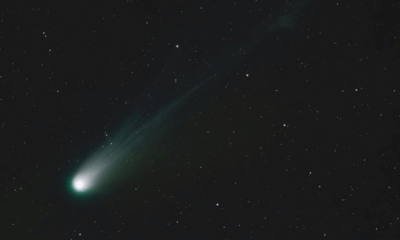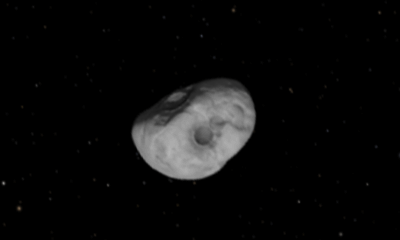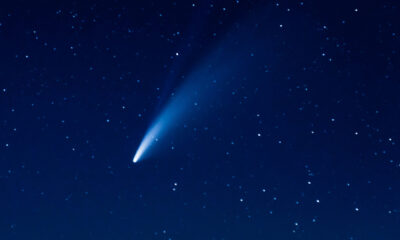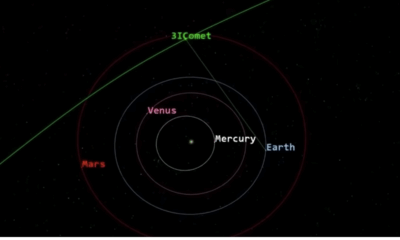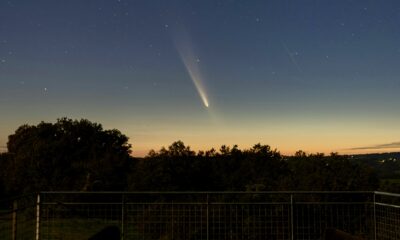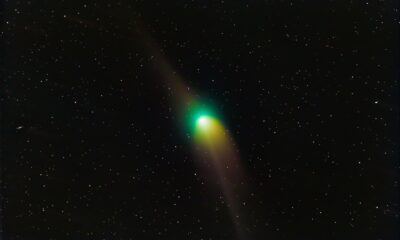Science
3I/ATLAS Approaches Critical Perihelion, Revealing Cosmic Mysteries
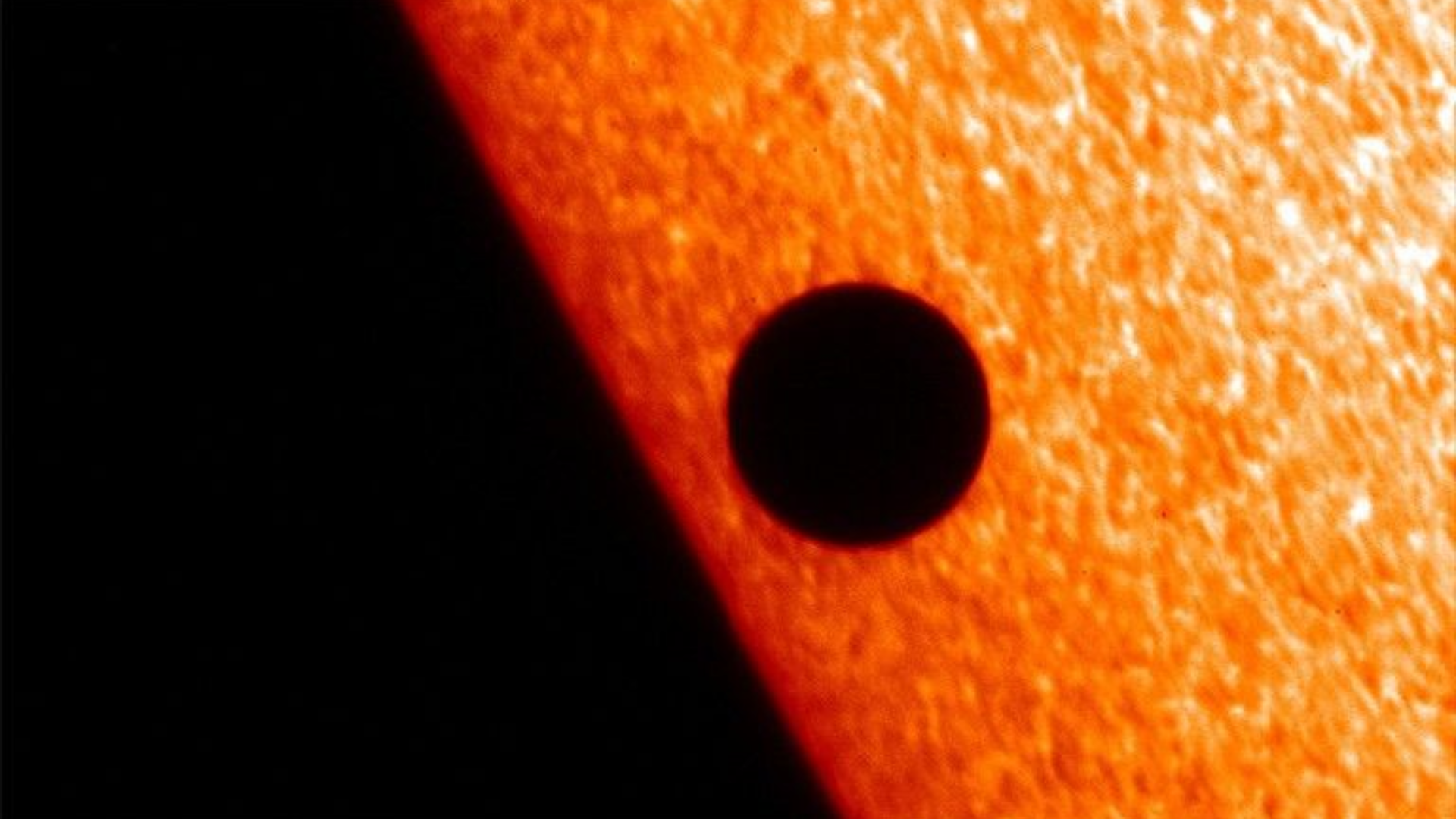
The interstellar object 3I/ATLAS is set to reach its closest point to the Sun, known as perihelion, on October 29, 2025. This significant moment marks the midpoint of its journey through the Solar System and could provide crucial insights into whether this enigmatic visitor is a natural comet or a product of artificial engineering. According to Harvard astrophysicist Avi Loeb, the approach to perihelion will serve as an ‘acid test’, as the intense solar radiation may reveal the object’s true nature.
As 3I/ATLAS comes within approximately 203 million kilometres (1.36 AU) of the Sun, it will experience solar radiation of around 740 Watts per square metre. This level of radiation is sufficient to cause fragmentation in a loosely bound icy body. Loeb posits that if 3I/ATLAS remains intact through this phase, it may indicate a more robust structure, possibly suggesting an artificial origin. “If it breaks apart, it’s glued together by weak forces. If not, perhaps something more durable,” he stated in a recent communication.
Most scientists currently maintain that 3I/ATLAS exhibits characteristics typical of a natural interstellar comet, lacking any credible evidence of technological origins. As it nears perihelion, astronomers expect it to brighten significantly as its icy surface vaporizes, generating gas and dust that form a visible plume. Nevertheless, Loeb has urged the scientific community to remain vigilant for any ‘technological signatures’ that could imply artificial construction. To date, no anomalies have been reported by either NASA’s Jet Propulsion Laboratory or the European Space Agency.
Exploring Potential Technological Origins
During perihelion, 3I/ATLAS will be positioned behind the Sun, rendering it temporarily unobservable from Earth until early November. Loeb speculated that if an intelligent civilization had influenced its trajectory, this hidden phase could provide an optimal opportunity to deploy mini-probes using gravitational assists. This viewpoint is met with skepticism by mainstream astronomers who consider such claims to be purely speculative.
Loeb, who leads Harvard’s Galileo Project, has cautioned policymakers to contemplate low-probability but high-impact scenarios. In a recent white paper co-authored with researchers Omer Eldadi and Gershon Tenenbaum, he likened 3I/ATLAS to a ‘Trojan Horse’, which may appear harmless yet conceal advanced technology within. In an appearance on Fox News America’s Newsroom, he remarked, “The city of Troy would have been better served if its guardians had not been fooled by the external appearance of the Trojan Horse.”
The Galileo Project team is analyzing atmospheric and telescope data from three observatories for any anomalous activity that coincides with the object’s solar encounter. So far, no irregular detections have been reported.
After perihelion, 3I/ATLAS will travel towards Venus, making its closest approach on November 3, 2025, at a distance of 97 million kilometres (0.65 AU). Its closest point to Earth is anticipated on December 19, 2025, at a distance of 267 million kilometres (1.8 AU). The object will continue on its path towards Jupiter, approaching within 54 million kilometres (0.36 AU) on March 16, 2026. While missions such as NASA’s Juno and the European Space Agency’s JUICE could collect incidental data during these flybys, neither agency has confirmed plans for direct observation.
Most planetary scientists classify 3I/ATLAS’s behavior as consistent with gravitational and thermodynamic predictions, reinforcing the idea that it is a natural interstellar comet. Loeb’s theory that it could serve as a mothership or probe remains unverified and highly speculative.
As Halloween 2025 aligns with its closest solar encounter, global observatories are gearing up to monitor 3I/ATLAS closely. Its passage, whether resulting in fragmentation or structural integrity, promises to enhance our understanding of interstellar visitors. For Loeb, this event serves as a reminder to “stay modest in our cosmic neighbourhood,” while for the broader scientific community, it presents a unique opportunity to explore how the universe communicates with us from beyond the solar system.
-

 Entertainment2 months ago
Entertainment2 months agoAnn Ming Reflects on ITV’s ‘I Fought the Law’ Drama
-

 Entertainment3 months ago
Entertainment3 months agoKate Garraway Sells £2 Million Home Amid Financial Struggles
-

 Health2 months ago
Health2 months agoKatie Price Faces New Health Concerns After Cancer Symptoms Resurface
-

 Entertainment2 months ago
Entertainment2 months agoCoronation Street’s Carl Webster Faces Trouble with New Affairs
-

 Entertainment2 months ago
Entertainment2 months agoWhere is Tinder Swindler Simon Leviev? Latest Updates Revealed
-

 Entertainment3 months ago
Entertainment3 months agoKim Cattrall Posts Cryptic Message After HBO’s Sequel Cancellation
-

 Entertainment2 months ago
Entertainment2 months agoOlivia Attwood Opens Up About Fallout with Former Best Friend
-

 Entertainment2 months ago
Entertainment2 months agoMasterChef Faces Turmoil as Tom Kerridge Withdraws from Hosting Role
-

 Entertainment3 months ago
Entertainment3 months agoMarkiplier Addresses AI Controversy During Livestream Response
-

 Entertainment3 months ago
Entertainment3 months agoSpeculation Surrounds Home and Away as Cast Departures Mount
-

 World2 months ago
World2 months agoCole Palmer’s Mysterious Message to Kobbie Mainoo Sparks Speculation
-

 Entertainment2 months ago
Entertainment2 months agoITV’s I Fought the Law: Unraveling the True Story Behind the Drama

